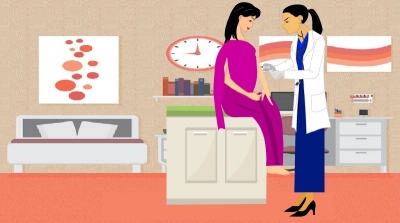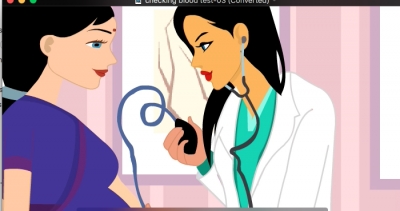Estimates of infertility vary widely among Indian states. Infertility in couples can bring about a feeling of loss, failure, disappointment and sometimes exclusion from the society. Infertility is defined as the inability to conceive after one year of actively trying. There are both male and female factors which can contribute to the childlessness of a couple. Let us first see what are some of the reasons for infertility in women -
Major causes of female infertility are -
-Problems with ovulation
-Structural problems
Problems with Ovulation - Most common cause has to do with ovulation. Female fertility decreases with age. Experts say that chances of conceiving decline with age, particularly after the age of 35. Woman’s fertility peaks in her 20's, and changes throughout her life. While some women remain fertile even into their late 30's, others experience fertility problems at a younger age. Because of changing hormones decreasing a number of eggs are produced or sometimes the egg may not be released during ovulation resulting in an anovulation - meaning eggs are not released every month during ovulation When, no egg is produced, no fertilization can occur and thus infertility.
PCOD or PCOS or Polycystic ovary syndrome is yet another major cause of anovulation caused by changes in the hypothalamus and pituitary gland which results in an imbalance of FSH and LH hormones. With the production of FSH reducing and levels of LH either remaining normal or increasing leads to the premature development of the ovarian follicles where the egg inside it does not mature properly. Cysts begin to form inside the ovarian follicle in certain cases. The number of empty cysts is seen within the ovary, which is why it is called a poly (many) cystic disease.Lifestyle changes resulting in stress and obesity caused by lack of physical exercise, changes in eating habits and pollution accompanied by medical disorders like diabetes. All these, in turn, lead to hormonal imbalance and problems with ovulation.
Structural problems - These are problems in the structure of fallopian tubes or uterus which causes difficulty in transporting of eggs and sperm. Some women are born with structural problems like an abnormally shaped uterus. Some may have fibroids which are benign masses growing in the wall of the uterus. Structural problems can affect the ability of the embryo to implant within the uterus. Damage to the uterus, ovary or the tube can also occur due to previous infections or surgeries which cause the walls of either the uterus or tubes to adhere and form scars. Endometriosis, where the uterine tissue is deposited in other parts of the reproductive system, can also affect fertility. Cervical secretions released by the women can sometimes cause the inability of the sperm to swim across to the egg.
The most common problems men face or the reasons for infertility in men are
- Low sperm count
- Morphology abnormalities
- Low motility of sperm.
- Premature Ejaculation
Treatment - Intrauterine insemination is done when either the man suffers from premature ejaculation or women has problems with cervix which prevents the sperm from meeting the egg. During intrauterine insemination, a thin catheter is used to introduce the sperm directly into the vagina. As the egg is released by the woman during ovulation the success of this treatment depends on the timing of the procedure. This has to be timed to be done during ovulation. The process is fairly painless and takes a few minutes. If a woman is considered a potential candidate for insemination, she is asked to take fertility pills for some time, so it helps in the process of ovulation - that is to make sure that eggs are released during ovulation and so the chances of getting pregnant are higher.
Another option is In-Vitro fertilization (IVF) where the women's eggs are removed from the ovary during ovulation and they are fertilized outside with the sperms in the lab. Fertilized eggs are then implanted in the womb. IVF is a good option for women who suffer from endometriosis where the tubes can be blocked by the uterine tissue. It is also considered when the man has a low sperm count. Even here the women are usually given medication for ovulation.
You may be given daily injections of fertility hormones. This will help in egg production. The eggs are usually retrieved just before they naturally emerge from the ovary. The woman will be constantly examined by u/s and blood tests to see if the eggs have ripened and ready for retrieval. The eggs have to be taken out at the right time. When it is time to retrieve the egg, the woman will be lightly sedated and the doctor, with the help of an ultrasound will be able to locate the follicles (each follicle is fluid-filled sac which contains the egg). A suction device will collect several eggs from inside the follicles and remove the eggs with the help of a hollow needle. Immediately following the retrieval the eggs will be mixed with partner’s sperms, which he would have donated shortly before the procedure. The woman is sent home. Once the fertilized eggs reach a more advanced stage of development i.e when the embryos are ready for implantation, The woman is asked to come back to the hospital and implantation of the embryo is done. The doctor will inject the fertilized embryo into the uterus through the cervix. The woman is discharged. The woman has to wait for a few days to see if the pregnancy happened or not. To increase the chance of pregnancy the doctor may recommend injecting up to 4 embryos at a time into the woman, however, this may increase the chance of the woman having a twin or multiple pregnancies. Age is a significant factor in the success of an IVF, about 35% of women will deliver a healthy baby.
Male infertility is extremely complex to diagnose and cure. Often, various tests are done to diagnose the problem. Semen samples are tested in the laboratory to know the sperm count, sperm strength, and other factors. Hormonal levels are checked to determine the testosterone levels. Physiological problems like defects in genital organs, Sexually transmitted diseases, retrograde ejaculation are also checked.
[quix id='8' name='About our Pregnancy Blogs and Videos']






